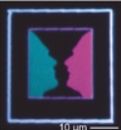News Archive
Light control of complex scenarios
October 2016. The control of biological systems dose-dependently in time and space is a key prerequisite for studying dynamic cellular processes in tissues or organisms in vivo. An ideal trigger signal for this purpose is light. “Caged compounds” have photolabile groups installed in key places to temporarily render biologically active compounds inactive. This approach typically leads to excellent ON/OFF behavior and has formed the basis of very interesting studies in chemical biology and material sciences and enabled the construction of useful nanoarchitectures. A major goal is three-dimensional resolution. Two-photon excitation can achieve this but the development of new two-photon-sensitive caging groups is very difficult, especially if they are to be applied in an aqueous context.
 A team of scientists led by Alexander Heckel has successfully introduced two-photon-sensitive photolabile groups into DNA strands and demonstrated their suitability for three-dimensional photorelease. A fluorescence-based strand-displacement assay in a hydrogel and in neurons served as the readout and enabled the scientists to establish parameters for well-defined three-dimensional uncaging. By using a second caging group with different spectral properties, the team has also shown that it is possible to perform the selective uncaging of one group over the other.
A team of scientists led by Alexander Heckel has successfully introduced two-photon-sensitive photolabile groups into DNA strands and demonstrated their suitability for three-dimensional photorelease. A fluorescence-based strand-displacement assay in a hydrogel and in neurons served as the readout and enabled the scientists to establish parameters for well-defined three-dimensional uncaging. By using a second caging group with different spectral properties, the team has also shown that it is possible to perform the selective uncaging of one group over the other.
The irradiation powers used were below or within the range of powers that are routinely used for two-photon imaging of live tissues. Photocontrol of hybridization by the use of nucleobase-caged DNA and RNA is a very general approach to confer light regulation to a large array of nucleic-acid-based techniques, as hybridization or the interaction of proteins with hybridized sequences are key to the regulation of biological function and nanoarchitectures. Now even three-dimensional resolution will be possible.
These results, published recently in the journal Angewandte Chemie - International Edition, pave the way to ever more complex scenarios of light control. More ...
Contact:
Alexander Heckel, Institute of Organic Chemistry and Chemical Biology, Goethe-University Frankfurt, Germany, heckel@uni-frankfurt.de
Publicaton:
Fichte MAH, Weyel XMM, Junek S, Schäfer F, Herbivo C, Goeldner M, Specht A, Wachtveitl J, Heckel A (2016) Three-Dimensional Control of DNA Hybridization by Orthogonal Two-Color Two-Photon Uncaging. Angewandte Chemie - International Edition 55: 8948-8952. http://dx.doi.org/10.1002/anie.201603281

